By Frédéric Bonnaud, translated by Jonathan Robbins in the March-April 2012 Issue
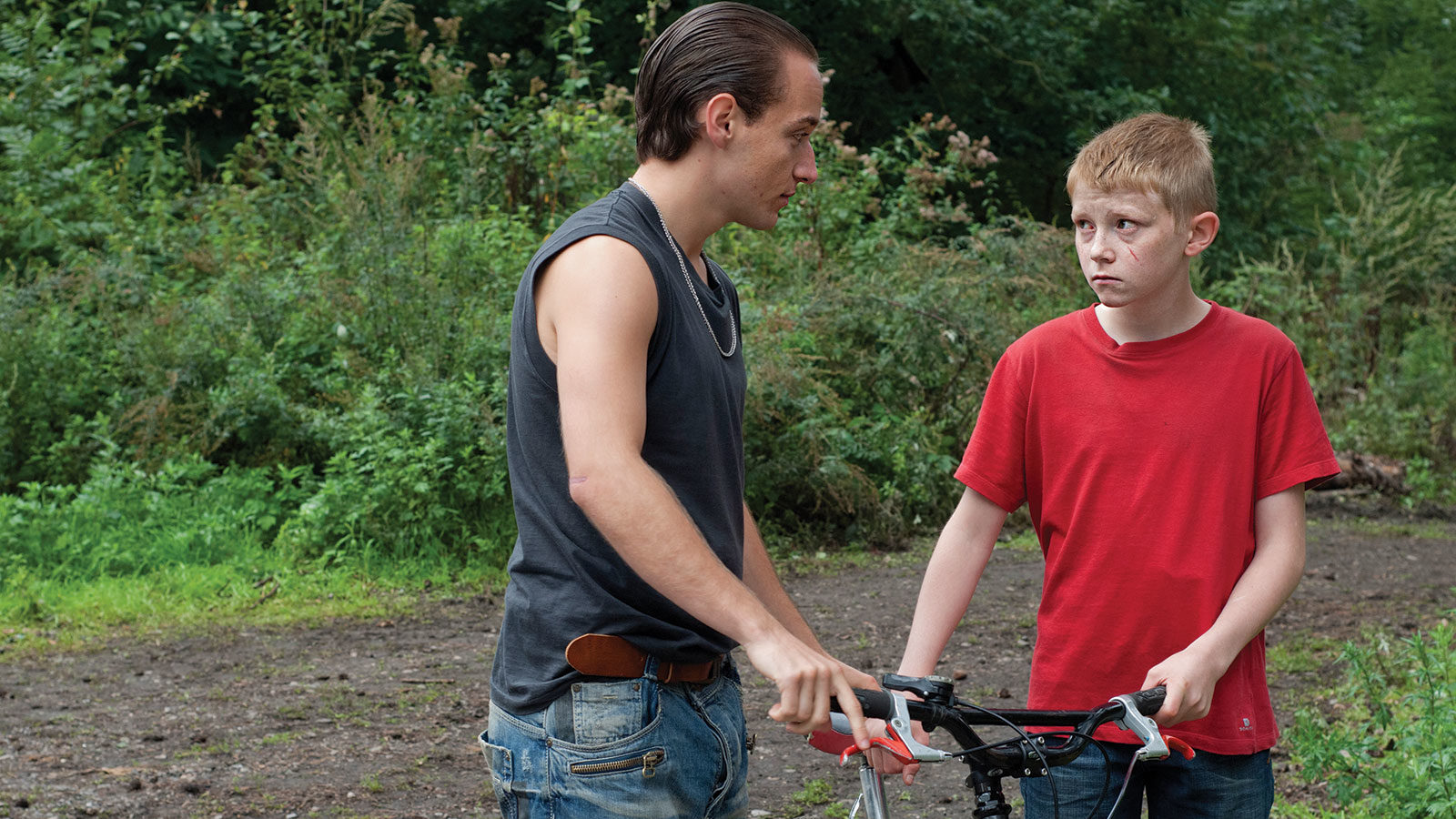
Radical Kindness
The Kid with a Bike leads Jean-Pierre and Luc Dardenne’s cinema of gestures and actions out of the shadows
Over the course of 12 years, the five films by Jean-Pierre and Luc Dardenne from Rosetta to The Kid with a Bike have received more awards than those of any other filmmakers in the history of the Cannes Film Festival: two Palmes d’Or, a Grand Jury Prize, one award for Best Screenplay, and two for Best Actor. They win something every time. And with each new film, an international jury declares itself amazed by its sophisticated realism. Without question, their cinema is peerless.
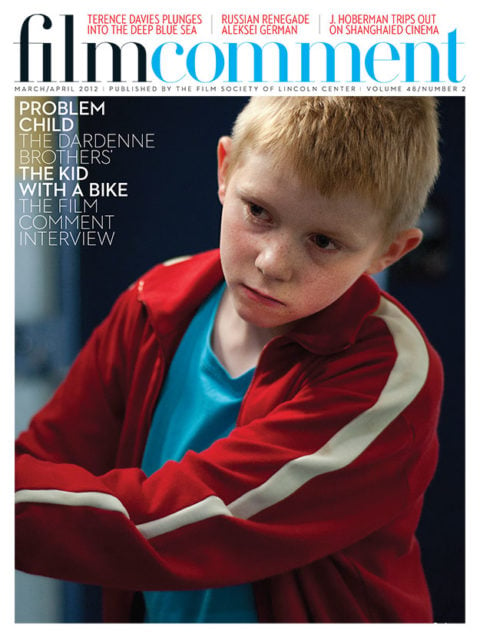
From the March-April 2012 Issue
Also in this issue
Nourished as much by Flemish Realism as Robert Bresson (the latter explicitly cited at the end of L’Enfant), and armed with their extensive experience as documentarians, the Dardennes have come to be the most acute observers of the new European proletariat, deprived of all protection by the implosion of the Eastern Bloc and the weakening of traditional social safety nets, as churches and unions become less and less powerful for their constituents. Without the support of these institutions, the Dardennes’ characters are reduced to a state of vulnerability. Like Rosetta on the streets of Seraing, whose small area and nondescript locations are enough to represent the entire world, they keep moving in order to stay alive. The only thing left to do is orchestrate the collision of these outcasts. They bump into each other—literally. Hence, the crucial importance of their trajectories, whether on foot, on public transportation, or by moped.
Collision, fall, and rescue: this is the Dardenne Brothers’ Holy Trinity. They have long been reluctant to acknowledge the obvious Christian inspiration of their artistic sensibility. But interviewed recently about their new film, they compare the moment when Cyril (Thomas Doret) and Samantha (Cécile De France) run into each other, causing an impassioned bond to form, to a “reverse Pietà.” This isn’t an acknowledgement of their possible Christian faith but an invaluable indication of the principal source of their fictional and formal inspiration: the inexhaustible body of Christian tales and their iconography. Today, the Virgin Mary is a childless young woman who cohabits with her boyfriend. And she adopts a lost child, who has lost his father and who rides around and around on his bicycle. In saving him, she commits herself fully to an act that is irreducible and mysterious. She achieves the impossible, like the father played by Olivier Gourmet in The Son, who finally gives up the idea of killing his son’s accidental murderer, thus making possible his own release, his own salvation.
As with each of their films, the Dardennes’ genius is to meld this imagery of popular faith with a perfectly realized context. Although the imagery should seem heavy-handed and outmoded, it gets lighter as it is mixed into the story and represented through a rough realism, grounded in social determinism and the reality of poor circumstances. Yes, The Kid with a Bike is indeed a Pietà—one that becomes a “Virgin and Child,” the initial and joyous episode of the ancient story. And no one has noticed…
For the Dardennes’ cinema, however shot through with Christian symbolism, is the least symbolic in existence. Everything about it is concrete and physical, heavy on what Marguerite Duras described as the “material life.” It is a cinema of vital gestures that must be fully carried out in order to finally emerge into the light.
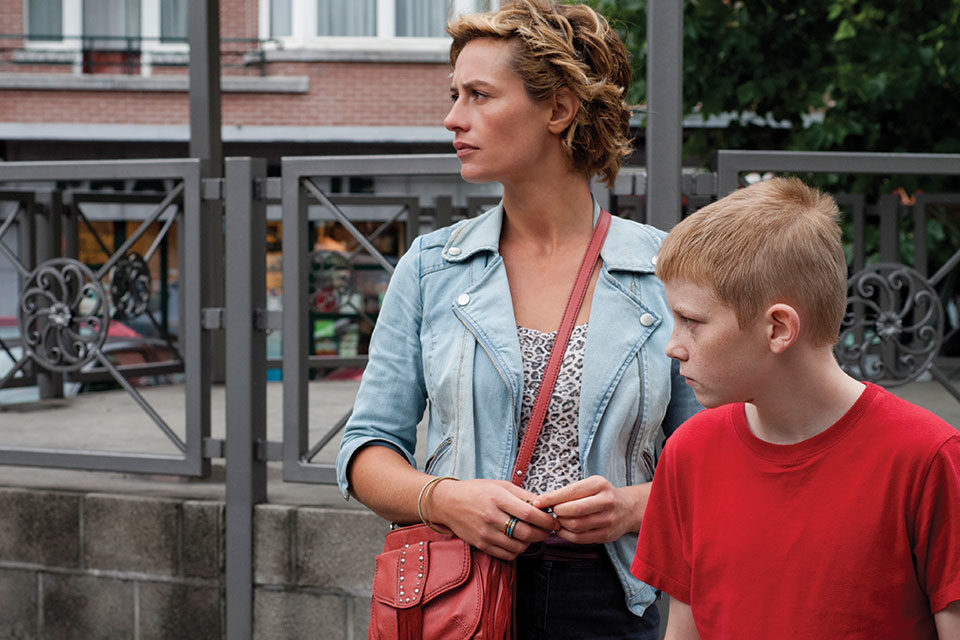
What was the starting point for The Kid with a Bike?
Jean-Pierre Dardenne: We were in Japan in 2002 for the release of our film The Son, as part of a campaign against the death penalty. Screenings of The Son were scheduled to be accompanied by a series of debates. During one of them, a judge specializing in juvenile cases told us the story of a kid dropped off at an orphanage by his father, who had promised his son he would come back and get him. For years the kid waited for his father to return.
Luc Dardenne: This story was running through our heads while we were working on another screenplay about a female doctor, a screenplay that didn’t come together in the end. We wondered how a woman could, in loving a child, ease his pain, release him from his violence, from his suffering.
The film follows a character literally consumed by an obsession: a boy who thinks only of finding his father.
Luc: Yes, and we gave this kid a bike, which makes him very mobile.
Jean-Pierre: The first escapes from childhood are by bike. It allows Cyril to leave in search of his father and to connect with Samantha. And it brings him to the woods where the bad guy awaits. The bicycle plays an important structuring role in the film. To bring it back to the obsession: he searches for his father for the first 15 minutes of the film. And then, for an hour and a half, he searches for love.
Thomas Doret’s acting is incredible. How did you find him, and how did you work with him?
Luc: He was the fifth child the team met during casting, and he was already impressive at this stage. So we asked him to play a telephone scene in which he had to make us feel how much he longed for his father to answer. His hand clenched the handset, his entire body tensed up…
Jean-Pierre: …he concentrated, and one could sense the presence of the father on the other end of the line, merely by the boy’s look. He was there, he existed, he took form. Thomas has discipline, he’s a brown belt in karate. He told us that he had begun karate at age 6 in order to calm his nervous energy. Before karate, he was unable to write, that’s how nervous he was. Now he’s able to control his body. But there remains within him the desire to keep moving. He’s a veritable electric battery! He gives the impression of being constantly energized.
Luc: At the age of 13, one is very prudish. Touching someone else’s body is not an easy or natural thing to do, especially that of an adult woman. We worked on that. Aside from that, you can’t direct a child. Our instructions were purely physical, related to the rhythm we wanted for the shot. All the rest, we stole from him: his manner of walking, of turning around, of playing with his fingers. But we didn’t work differently with him than with Cécile.
Jean-Pierre: Who, for her part, looked for ways to hide her acting technique, to return to a raw state. This was a real triumph for her. She was very generous. Jérémie Renier [who plays the boy’s father], too.
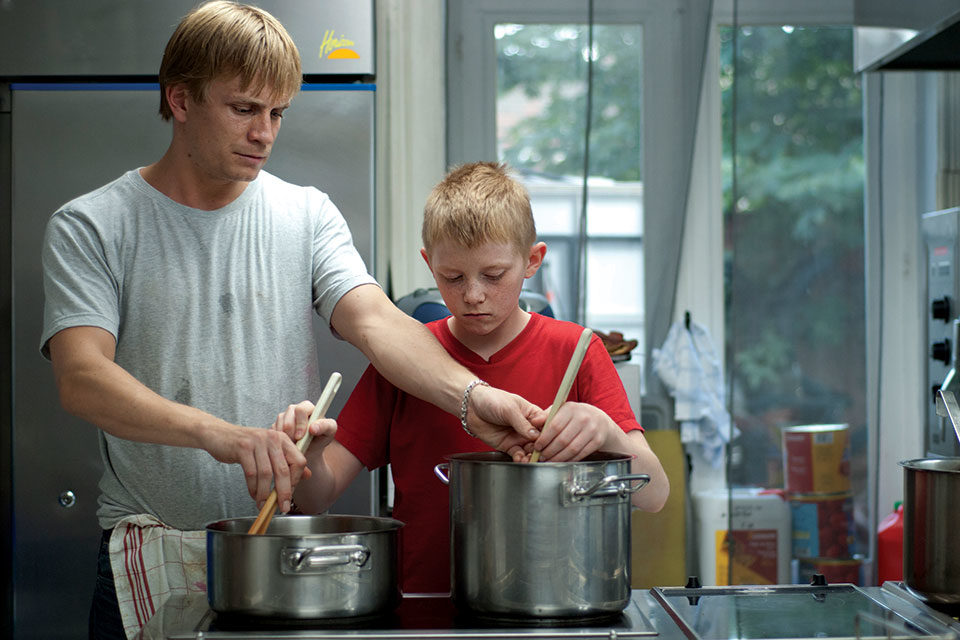
There is a refusal to psychologize. The film never tells us why this luminous young woman would take this lost child under her wing. Something very simple happens: he literally runs right into her. There is a collision between them, a shock, and boom! They are bound for life.
Jean-Pierre: Exactly. The reasons for Samantha’s behavior aren’t to be sought in what came before in her life, nor in her psychological makeup. But they’re there to be seen, to be felt in this encounter where he holds her in his arms, causes her fall to the floor, and won’t let go of her. A little like a reverse Pietà, because it’s he who holds her. She feels his distress and she cannot behave otherwise.
Luc: And what she’ll do for him goes quite far. She chooses this little boy over her boyfriend who is irritated and asks her to choose between them. The answer is clear to her.
All the same, it’s still a mystery. Is there an explanation for this choice?
Luc: Kindness has a mysterious aspect. But wanting to find Samantha’s reasons is tantamount to minimizing her kindness. Because kindness, cer- tainly more than Evil, scares people. Kindness isn’t rational. Samantha feels called upon by this kid and she responds to his call. She chooses him and he likewise chooses her. That was enough for us. And for Cécile as well.
Jean-Pierre: We explained this to Cécile, who, as a good actor, wanted to know more, to know if the character had a particular kind of background. We explained to her that we wanted the viewer to watch the film with precisely that question: why does this woman do this? We told her: “With your body, your luminosity, your presence, you will carry the viewer along with you.” Sitting before her, the viewer abandons this inquiry that is, in fact, suspicion. Suspicion that she’s accepting the boy for the wrong reasons, that she is trying to get over something. As if she needed to get over some past drama or the lack of a child.
Luc: I believe that we all have this humane sympathy. Samantha does what we should all do in her situation. This kindness surprises us. It makes us forsake our normal habits and take dangerous paths. It’s revolutionary.
Your style is recognizable in this film, but the treatment of color is very different, with large on-screen expanses of vivid colors: the red of the kid’s T-shirt, the colors of the buses, the summer light.
Jean-Pierre: The light is more varied. There is something more shimmering to it. Also, we wanted to change. We wanted to film moments of happiness—the River Meuse beneath the sun. The film’s sense of light testifies to this. The shoot, too, was very upbeat. In great part due to a kid who communicated his enjoyment of acting to everyone.
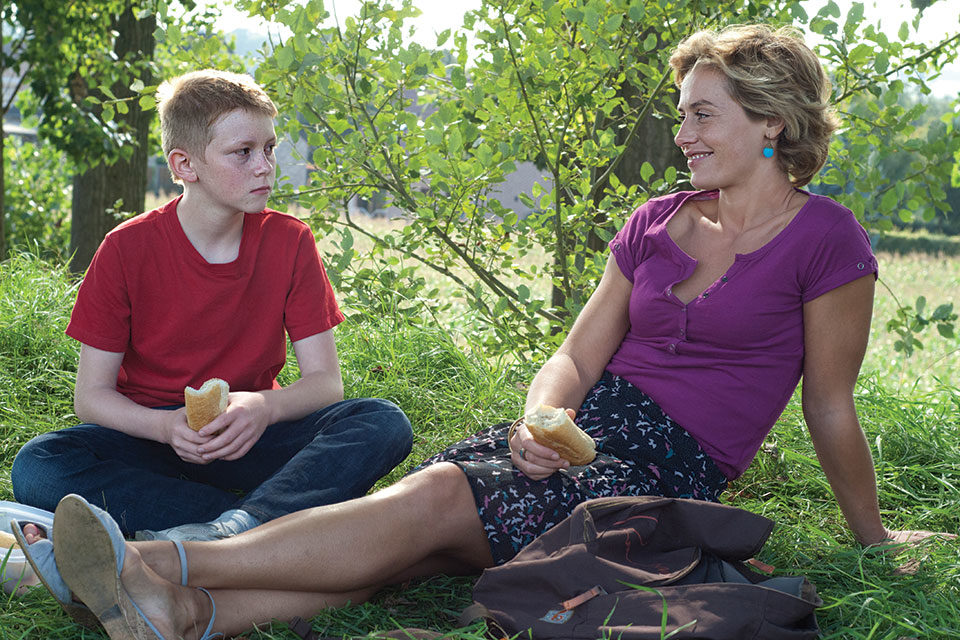
In the sense of a chanson de geste [a form of medieval performance in which epic poetry is accompanied by song and pantomime], in a way you make a cinéma de geste [a cinema of actions or gestures]. There’s a scene where the kid is playing with the faucet in the hair salon. Interminably. He exasperates Samantha and the viewer as well. It’s a strong gesture, at once precise and inconsequential. How do you locate such a gesture while writing the screenplay?
Luc: We thought of water for that particular scene. The kid has just learned some terrible news and he’s unable to speak. So he lets the tap run and watches as it flows between his fingers, whereas something is frozen inside him that he can’t communicate. Something is blocked. So this water enables him to piss Samantha off, to draw her in, to capture her attention. What he has to tell her is so difficult.
The film has relatively few locations. The characters appear in a kind of circle, passing by the same places, as in those fairy tales where a character is constantly retracing their steps.
Jean-Pierre: It’s geography that drove the film more and more toward being a fairy tale. When we started to scout for locations, still without a screenplay, we already knew where we wanted to shoot: a housing block in Seraing, a road, and on the other side some woods. And at the other point of the triangle, a gas station. The organization of locations obliges the kid’s character to keep going back to the same places, to keep making the same trips, and finally to approach the woods, a place of danger, with its sort of evil shed.
Luc: The idea of the fairy tale came to us when we filmed the kid entering the woods—this little red figure faced with the seemingly immense forest. Another story began, the film’s third part. The forest, a place charged with strangeness, implies a fairy-tale logic, with Samantha as the good fairy.
Do locations determine the mise en scène? Or are locations sought out and chosen according to the dictates of the mise en scène? I am thinking of a particular scene: the kid wants to reach his father, who works in a restaurant. Going around back to get in, he climbs over the same wall several times. It gives the film a fantastic, worrying, secret quality. We’re scared he’ll get hurt, and of what might be behind the wall. Did the wall have to be there?
Jean-Pierre: We built the wall and the alley according to the needs of the mise en scène. The father is a secret we’re concealing, and we wanted to have an obstacle that needed to be overcome in order to reach him.
Luc: In the beginning, we need to have places that actually exist, but it’s true that this time we altered them a bit more. Maybe this film is less realist in that respect. The father’s restaurant is a kind of safe that the kid cannot get inside. Hence the wall. We make physical cinema: we love having our characters go through doors or over walls, we love doing fight and chase scenes.
Jean-Pierre: Cécile had just come back from shooting with Clint Eastwood, and she told us that with him, one take was often enough, even sometimes just the rehearsal. And Thomas, very impressed, became obsessed with the idea of doing just as well!
Is the film a melodrama?
Luc: Even if we didn’t try to follow the rules of melodrama, you can find elements of the genre: the bad guy who tempts the innocent, the reunion scene, the search for the father, the gentle and loving maternal figure. Melodrama allows for greater freedom in the relationships between characters. Within its framework, you dare to do things that seem larger than life, which aren’t at all realistic. And then we arrive at a way to make them believable, to make them live in the spectator’s heart.



